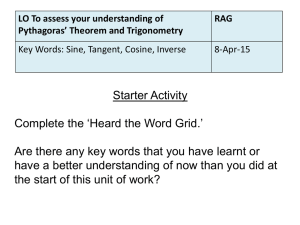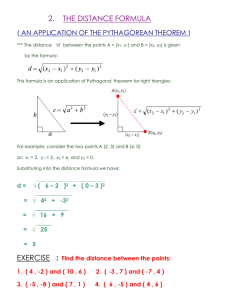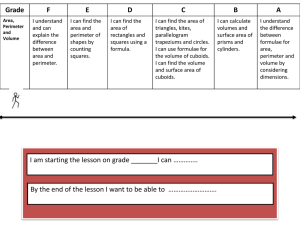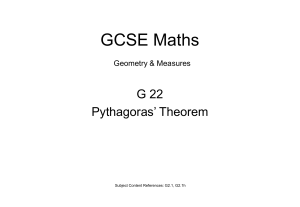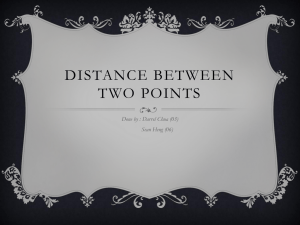Teaching and learning plan on investigating Pythagoras`s theorem
advertisement
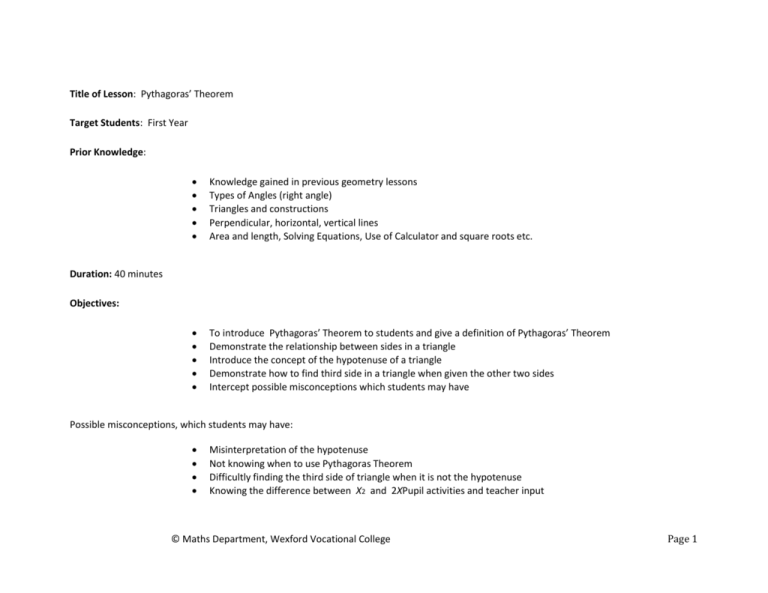
Title of Lesson: Pythagoras’ Theorem Target Students: First Year Prior Knowledge: Knowledge gained in previous geometry lessons Types of Angles (right angle) Triangles and constructions Perpendicular, horizontal, vertical lines Area and length, Solving Equations, Use of Calculator and square roots etc. To introduce Pythagoras’ Theorem to students and give a definition of Pythagoras’ Theorem Demonstrate the relationship between sides in a triangle Introduce the concept of the hypotenuse of a triangle Demonstrate how to find third side in a triangle when given the other two sides Intercept possible misconceptions which students may have Duration: 40 minutes Objectives: Possible misconceptions, which students may have: Misinterpretation of the hypotenuse Not knowing when to use Pythagoras Theorem Difficultly finding the third side of triangle when it is not the hypotenuse Knowing the difference between X2 and 2XPupil activities and teacher input © Maths Department, Wexford Vocational College Page 1 Student’ Learning Tasks: Teacher Input Lesson Interaction Student Activities: Possible Teacher’s Support and Actions and Expected Responses Checking Understanding Part 1 : Discovering a pattern – the longest side squared in a right angled triangle equals the sum of the other two sides squared You can work in pairs so that you can Construction of a triangle Teacher circulates checking that students are The Van Hiele Theory is applied check each other’s work but still draw given SAS constructing the triangle accurately here as the language engaged in your own triangle. by the teacher plays an First, I am going to ask everyone to draw important role. accurately a line segment measuring 3cm. Having done that, draw another line segment measuring 4cm perpendicular to the first line segment. Join the two free ends of the line segments with another line segment. Students are surprised to Measure the third line segment. realise the teacher already Teacher gives the correct answer for the Are students measuring and When you measure it, I will be able to give knows the length of the length of the third side. drawing accurately? you the answer and you will be able to tell third side me if I am correct. Repeat the above for right-angled triangles with sides 6, 8, and 5, 12. Complete the triangles and measure the third side and I will be able to give you the answer without measuring. Give me any 2 sides beside the right angle in a right-angled triangle and I can tell you the length of the third side. You can draw and check it by measuring. Students draw, measure, and ask the teacher for the answer. Students choose their own lengths for the 2 sides of a triangle using SAS with the A = 900. They measure the third side and then ask the teacher for the answer and find that the teacher is able to give the correct answer without measuring. © Maths Department, Wexford Vocational College Again, the teacher predicts the correct lengths for the third side. Are all students participating? With the aid of the calculator, the teacher determines the measure of third side for the students. Page 2 Can you see a pattern? Look at triangles with sides 3,4,5 and 6,8,10 and 5,12, 13 Some may see the pattern Using the 3, 4, 5 triangle, square the three sides. Do you now see a pattern? If you do, tell the class what it is and then write it down in your own words. Some students may see the pattern that 2 of the sides squared added give the third side squared. If you are not seeing a pattern, try adding the squared numbers together to see if a pattern exists. At this stage most students will see the above pattern Repeat squaring the sides for the 6,8,10 and 5, 12, 13 triangles and write down the pattern you see. If some students see a pattern, ask them to explain it to the class. Students may need to be given the hint to square all sides but the teacher gives students time to think before giving the hint. Teacher helps students having difficulty by getting them to add the squared numbers in different combinations. Students see that the largest side squared equals the squares of the other two sides added together. Repeat this for the other right-angled triangles you have drawn. Again, write down the pattern you have found. When I squared the two shortest sides and added them I got the longest side squared. How did I then get the longest side? Do this for each of the triangles 3,4,5 and 6,8,10 and 5, 12, 13 to find the longest sides in each case You got the square root of your answer. Students square the 2 longest sides, add them, get the square root of their answer, and check with their measurements. © Maths Department, Wexford Vocational College Teacher checks that students can find the square root using the calculator. Page 3 Part 2: Noting that the biggest angle in a right angled triangle is 900, the longest side is opposite this angle and it is the hypotenuse Given a triangle with one angle equal to 900 can either of the other angles be 900? Explain. The 3 angles add up to 1800 so the other 2 angles have to add up to 900 and are therefore less than 900. Therefore, what size is the largest angle in a right-angled triangle? 900 Using the right angled triangles you have drawn with sides 3, 4, 5 and 5, 12, 13 and 6, 8, 10 what do you notice about the longest side and the angle opposite it? The angle opposite the longest side is 900 and it is the biggest angle in the triangle. We have a special name for the longest side in a right-angled ∆. It is called the hypotenuse. It will always be the line that is opposite the right angle. Distribute Student Activity 1 On the Student Activity can indicate where the hypotenuse is on each of the triangles Students will work on the student activity identifying the hypotenuse of various triangles Teacher draws a diagram of a right-angled triangle on the board. Students may need help with the word”opposite” - teacher explains using an arrow from the right angle to the longest side. Using the diagram on the board of a rightangled triangle, the teacher labels the longest side as the hypotenuse and writes it in new words list on the board. Can students correctly identify the hypotenuse? Teacher distributes Student Activity 1 to each student. Teacher will stimulate learning and encourage students to ask questions. © Maths Department, Wexford Vocational College Page 4 Part 3:Using Pythagoras Theorem Model Can we all look at this model and tell me where the right angle is? How many degrees in a right angle? Point to the right angled triangle in the model and ask students to identify its side lengths (3units, 4units, 5units) Place the Pythagoras Model on Overhead Projector to ensure all the class can observe work 900 Observe model on the overhead projector Building squares on the 2 smaller sides what is the area of each of these squares? 9 and 16 Ask one student up to the top of class to fill in the contents of the two smaller squares into the bigger square. Can you tell me if there is a pattern here? The areas of the 2 smaller squares added together equal the area of the square on the hypotenuse Which side has the largest area built on it? The hypotenuse What do you conclude? In this right angled triangle the area of the square built on the hypotenuse equals the area of the squares on the other 2 sides added together. Are students able to verbalise the pattern they have seen – Pythagoras’ theorem in terms of areas? Teacher aids student in demonstrating the concept of Pythagoras’ Theorem on the overhead projector Teacher asks various students to verbalise what they have observed. © Maths Department, Wexford Vocational College Page 5 Part 4 History of the Pythagoras Theorem and reinforcing the verbalising of same We have discovered an amazing fact about right-angled triangles. However, unfortunately other people knew this before we did. A very long time ago over 3,000 years ago Egyptian, Babylonian and Greek Mathematicians discovered this, but years later a man named Pythagoras, a very famous mathematician proved it was true. That is why we call it Pythagoras’ Theorem. Some mathematicians argued that he stole the idea. Pythagoras proved that for any right angled triangle the square of the hypotenuse is equal to the squares of the other two sides added together h2= a2+b2 For what types of triangles does this work? Teacher shares the history of Pythagoras with the class and asks the class to look up Pythagoras on the internet and share their findings next day. Pythagoras’ Theorem only works for right-angled triangles. What did you all notice about the length of the three sides of each triangle we have looked at today when we squared them? Two of the sides squared added up to the third side squared. Working in pairs write down, in your own words, the pattern we have found in rightangled triangles. Test each other to see that you can state the pattern. In a right-angled triangle, the square of the hypotenuse is equal to the squares of the other two sides added together. Teacher uses the right-angled triangle drawn on the board when verbalising the theorem. © Maths Department, Wexford Vocational College Are students able to state the theorem with understanding and using correct terminology? Page 6 Part 5: We are now going to demonstrate the Theorem of Pythagoras in different situations We want to find the length of the diagonal of our desks. What does this have to do with what we have been learning in Pythagoras’ theorem? How do you calculate the length of the diagonal using what you have learned from Pythagoras’ Theorem? If we know the square of the hypotenuse, how to we find the third side? Write down calculations and compare with measured value of the diagonal. All the desks in the room seem to be approximately the same size – is this true? If you had to bring a beam of wood which was slightly taller than the doorway, through the doorway, how would you do this? The desk is rectangular and is made up of 2 right-angled triangles. The diagonal is the hypotenuse. Square the 2 smaller sides and add and this gives us the square of the hypotenuse. Find the square root of this number using the calculator. Students measure two sides of their desk and calculate the hypotenuse. Students check their answers using the measuring tape to measure the length of the diagonal. Students compare their answers with other students. If their answers are very different, they recheck their measurements. Bring it in along the diagonal as it is the longest side of a right angled triangle © Maths Department, Wexford Vocational College Teacher allocates measuring tape to each group to enable them complete their task. Teacher will answer any questions and observe work checking that they know which side is the hypotenuse. Emphasise that Pythagoras’ Theorem only applies to rightangled triangles. Teacher emphasises the hypotenuse squared = squares of other 2 sides added together. Check that students know how to get square root on their calculator. Did the measured length of the diagonal agree with the calculated length? Teacher checks for understanding of the definition. Can they calculate the hypotenuse? Can they explain in their words what they are doing? Are students able to apply Pythagoras’ theorem to calculate the hypotenuse in a right-angled triangle? Page 7 Part 6: Using Student Activity 2, calculate the length of the hypotenuse in these right-angled triangles. Students work in pairs and use Pythagoras’s Theorem in determining the hypotenuse of a right angled triangle given the other 2 sides. Teacher distributes Student Activity 2 Recap definition of Pythagoras’s Theorem If necessary, use the board to demonstrate the calculation of the hypotenuse. Teacher circulates to see if students are able to complete the Student Activity. Part 7: Using Student Activity 3 calculate the missing third side in these right angled triangles when we are given the hypotenuse and one other side in a right angled triangle. Finally, here are some more questions where we will have to find a side of a right angled triangle Students work in pairs and use Pythagoras’s Theorem in determining the length of a side in a right angled triangle given the hypotenuse and one other side How do we find the third side? Recap Define Pythagoras’s Theorem and what you have learned today. Homework Complete Student Activities no. 2 and 3 for homework and find information on Pythagoras on the internet. © Maths Department, Wexford Vocational College Are students able to apply Pythagoras’ theorem to calculate the length of any one of the three sides in a right-angled triangle given two of the lengths? Teacher distributes Student Activity 3 If necessary, use the board to demonstrate the calculation of the missing third side. Teacher asks different student to state Pythagoras theorem and when it is used Page 8 Student Activity 1: Label the hypotenuse in these right angled triangles 1. 3. 2. 7. 5. 4. 6. © Maths Department, Wexford Vocational College Page 9 PYTHAGORAS THEOREM Student Activity 2 NAME:________________________________ EX. 1 EX. 3 EX. 2 7 x 12 x 15 x 24 5 8 x2 = 52 + 122 x2 = 25 + 144 x2 = 169 x = √169 x = 13 EX. 5 EX. 4 EX. 6 15 x 8 2 0 x 18 x 11 10 x2 = 82 + 112 x2 = 64 + 121 x2 = 185 x = √185 x = 13·60(c. t .2.d.p.) © Maths Department, Wexford Vocational College Page 10 PYTHAGORAS THEOREM Student Activity 3 EX. 1 EX. 3 EX. 2 15 12 2 0 x 50 48 x 12 x 152 = x2 + 122 225 = x2 + 144 225-144 = x2 x2 81 = √81 = x 9 = x EX. 4 EX. 5 EX. 6 11 8 x 20 7 8 2 = x2 + 7 2 18 x x 14 64 = x2 + 49 64 – 49 = x2 15 = x2 √15 = x 3· 87 = x(c.t.2.d.p.) © Maths Department, Wexford Vocational College Page 11 Teacher’s Board NEW WORDS Hypotenuse Pythagoras Theorem 8cm C2 = A2 + B2 10cm B C Hypotenuse 6cm A C2 = A2 + B2 C2 = 62 + 82 C 2 = 36 + 64 C 2 = 100 C = 10 © Maths Department, Wexford Vocational College Page 12

